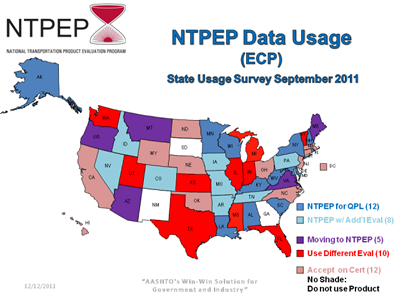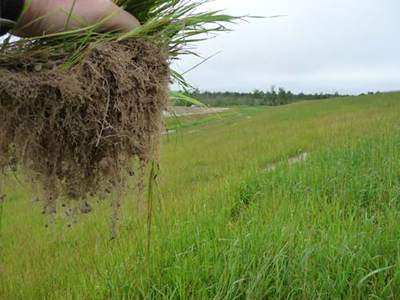In this two-part series, Katie Westfall writes about the positive impact the National Transportation Product Evaluation Program (NTPEP) and the implementation of large-scale (or full-scale) erosion and sediment control testing are having on the field. This article has been updated from its initial version in September 2011. A link to Part I is provided at the end of this article.
THE FUTURE OF THE PRACTICE
 |
“Standardized testing is essential for proper comparison of products,” says Tracy Gore, a Construction Technology Leader with the Alabama Department of Transportation’s (ALDOT) Construction Bureau. She recognizes, though, that the vast differences in soil types, precipitation levels and climates throughout the United States have complicated standardization efforts. Gore has served on NTPEP’s Erosion Control Products Testing Program Committee since 2009.
“These variations make it difficult to write a national standard specification,” she says.
The differing types of products, and their disparate performance within these varied environments, also complicate matters.
“There are installation limitations for both rolled and hydraulic erosion control products,” Gore says. “For example, rolled erosion control products cannot be easily installed to contact the soil surface on hard soils or on irregular surfaces. Hydraulic erosion control products cannot be used in channel flow applications or in areas subject to frequent flooding. However, both rolled and hydraulic erosion control products have comparable abilities to protect against rainfall impact erosion.”
The recognition of both rolled and hydraulic products is essential. In many instances, they can be used in the same way. But not every product within each class is applicable. In that lies the heart of the argument: how to identify the best BMPs.
Objective, quantitative “proof” then becomes more important, especially as product options and manufacturer numbers increase. Manufacturing quality controls via in-house index testing labs, independent manufacturing quality assurance via independent third-party agencies (such as NTPEP), and relevant, comparable performance evaluations via accredited independent testing labs together provide a “systematic” path to defining Best Management Practices.
It has become imperative to utilize standardized, comparative, quantitative information throughout the product evaluation process. This has already been discussed concerning the use of index and bench-scale tests for quality control and quality assurance. Still, it is equally important to the effort to understand the real-world implications and expectations of one product or product type versus another, and this can be clearly quantified in large-scale performance testing. Large-scale testing is the only way to assess the effect of the recommended installation practice(s), such as anchorage type and frequency or coverage rate and minimum cure time, on performance.
“I believe that the lack of performance testing standards for erosion control products has inhibited their recognition as ‘engineered’ products by many in the design community,” says Tim Lancaster, Director of Technology – Erosion Control and Marine, North American Green. He has been closely involved in developing programs with ECTC to provide clearer data for end-users.
“The leading product manufacturers have in the past developed their own large-scale testing protocols in order to establish design values and guidelines for their products, but many engineers are hesitant to accept performance data from ‘non-standardized’ tests.”
Additionally, various universities and agencies have performed versions of large-scale tests. With each organization using different protocols, it has meant that the performance information available until recently has been unique for each laboratory; thus, making it impossible to compare results produced at different labs.
These efforts, while not universally beneficial, have certainly not been wasted. They’ve been central to the path the field now finds itself on. “Many of the elements of manufacturer-designed test protocols have now been rolled into ASTM testing standards,” says Lancaster. “[These] certainly help legitimize erosion and sediment control products and their functionality.”
And they do.
ASTM has listened and has steadily progressed with the standardization of large-scale protocols. Beginning in 1999, the ASTM consensus standards have provided the public with full details of how to run relevant large-scale tests, including the specific size, boundary conditions, reporting requirements, and all other testing details. Thus far at least two laboratories have implemented test procedures in accordance with these standards.
One of those labs is located in Anderson, South Carolina: the Denver Downs Research Facility (DDRF). DDRF is the world’s first accredited laboratory for the full-scale testing of erosion and sediment control products.
“Accreditation is a way of assuring that a lab is running ‘letter of the law’ standardized large-scale tests,” says Joel Sprague, Senior Engineer for TRI/Environmental. He provides technical oversight of the four-acre DDRF site in Anderson. It has been accredited by the Geosynthetic Accreditation Institute’s Laboratory Accreditation Program (GAI-LAP), and NTPEP has contracted with TRI to have it conduct the critical erosion control product testing for NTPEP’s member-distributed reports. TRI is also the same company that was engaged by ECTC in the 1990s to develop standardized index and bench-scale tests for erosion and sediment control products.
As with index and bench-scale testing, the use of ASTM’s consensus standards is important for large-scale testing. It is NTPEP’s openly declared preference to use agreed-upon, established standards in its process.
“The standards available to us,” Sprague says, “provide an impartial guide as to how these tests must be conducted so that they are repeatable, dependable and fair. They are readily accessible to both users and manufacturers and provide dependable, basic performance information.”
Key ASTM full-scale performance tests of note at DDRF include:
- ASTM D 6459 – Determination of Rolled Erosion Control Product (RECP) Performance in Protecting Hillslopes from Rainfall-Induced Erosion
- ASTM D 6460 – Determination of Rolled Erosion Control Product (RECP) Pe
rformance in Protecting Earthen Channels from Stormwater-Induced Erosion - ASTM D 7208 – Determination Of Temporary Ditch Check Performance In Protecting Earthen Channels From Stormwater-Induced Erosion
- ASTM D 7351 – Determination Of Sediment Retention Device Effectiveness In Sheet Flow Applications
(NOTE: While these four tests are all full-scale performance tests, D6459 and 6460 are the only large-scale tests available at the moment for NTPEP reports.)
The transparency of the process and the repeatability of the procedures lead to results that can confidently be used to compare alternatives.
“No matter what the product is, or how it is installed, slope dimensions are identical,” Sprague says. “Channel hydraulics are commonly interpreted. Rainfall intensities are repeated. Soil veneers are compacted to the same thickness. And: the installation details are clearly recorded.”
 |
John Ravert, Technical Director for East Coast Erosion Control, also believes that large-scale performance tests can provide more accurate and useful data in some instances than conventional bench-scale testing. For example, there is a dramatic difference when testing a product for sheer stress.
“On the bench scale,” Ravert says, “they put it in a round pot, really like a kettle. And then they just apply the water to that, and that’s it. You go into a large-scale test, you’re looking at a 40-foot-long slope and you get a much better sense of soil loss. It gives you a real-world application.”
He considers large-scale to be the most valid way to determine the efficacy of a product.
“If you have a large-scale performance [test],” he says, “you’re running down three slopes, and you’re increasing the flows, and you have replicates and you’ve got a baseline to compare….You’re definitely getting a better analysis of what a product should do.”
Given the range of product classes and the variations within each class, that assured consistency is central to validating not only the per-product data but, ultimately, the entire industry’s breadth of quality. For example, a double-net erosion control blanket with straw installed with 2 staples per square yard may be the presumed choice for a particular application. RECPs of this nature have been regularly included in NTPEP reports since 2003, but they do not represent the limit of real options. It may be that more recently incorporated products, such as hydraulically-applied erosion control products (HECPs) applied at a coverage rate of 3500 pounds per acre and cured for 48 hours, are just as effective. For the user making the purchasing decision, the latter choice may turn out to be more readily available or economical without sacrificing any site effectiveness. Or a site-specific combination of these technologies may be the best approach.
“Standardized testing is essential for proper comparison of products,” says Tracy Gore. “Testing data shows that there is not a direct correlation between the type or makeup of a product and the performance of a product. It is very important to review large-scale testing data to determine the anticipated field performance when approving products for use.”
One solution may seem like apples and the other like oranges, but objective data collected on how they actually perform in like situations highlights exactly why these are apples-to-apples comparisons—how these BMPs may both be best, in which case economics can be the deciding factor.
Large-scale testing is currently optional to the manufacturers participating in the NTPEP program. Some states, including Alabama, are requiring large-scale testing from AASHTO NTPEP.
In October 2011, the NTPEP Erosion Control Products testing committee published a key guidance document. This document has been designed to help states understand and utilize the testing data. It will be continually updated, as needed.
ADDITIONAL ADVANTAGES
Inclusion in the NTPEP program requires that products be subject to independent quality assurance testing via index and bench-scale testing every three years. Large-scale performance testing is currently optional. Yet, the impact of NTPEP’s offer to incorporate full-scale performance data lets the manufacturer go beyond proving product quality to proving product performance using their recommended installation practices.
“A key component of product performance,” Gore says, “is following the manufacturer installation recommendations such as staple patterns/frequency and application rates.”
In addition to submitting products for testing, participating manufacturers must also have in place strong quality control programs that routinely test both raw materials and finished goods in-house. These manufacturer-directed control programs must produce data using standardized tests and at frequencies that provide a clear view of process controls. This data must be readily available.
Also, NTPEP requires signed certificates of product quality and reserves the right to conduct random, independent sampling of materials from manufacturers for quality assurance purposes.
Quality control and quality assurance checks are becoming common in the erosion and sediment control products industry; but joining them with an outside, independent process and relevant, standardized performance characterization tests is what makes the overall NTPEP process so valuable here, as well as valuable beyond the DOT members who immediately benefit from the product reports.
Full-scale testing is certainly not the last step in this dynamic field’s evolution, but it seems to be the final step in the industry’s maturation. The process officially began with the development of those first, key standardized tests in the 1990s; and it has now led to a process that gives erosion and sediment control products and producers the full vetting and quality recognition that makes them consistent with other common (and necessary) construction products.
“The broad reach of NTPEP, the considerable product-purchasing investments made by its members, and the influence this synergy can have on product industries represents a tremendous opportunity for erosion and sediment control,” Sprague concludes. “NTPEP’s process supports and protects designers and end-users and facilitates free and fair markets. It’s a process, and just a process; but it is a process that has been missing and one that is welcomed.”
SEE ALSO: "NTPEP: Making Best Management Practices Better – Part I"
Katie Westfall is a writer based near Orlando, Florida.











